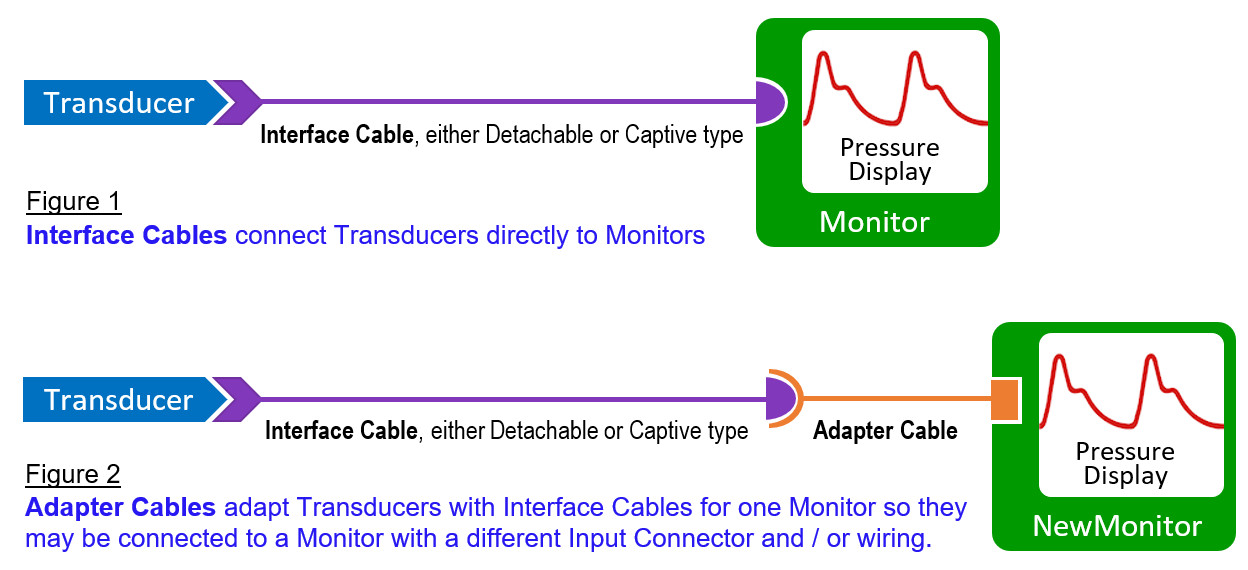Your shopping cart is currently empty.
Interface and Adapter Cables explained . . .
We make Cables to connect Transducers and Monitors. Click for a list.
We make Cables to connect Transducers and Monitors. Click for a list.

When determining which type of cable is best suited to your application, it is useful to understand the difference between Interface Cables and Adapter Cables. Adapter Cables are short, typically about 12 inches long (but we offer them in special lengths as well). Interface Cables are much longer, typically about twelve feet long.
The primary purpose of Interface Cables [Figure 1] is to connect IBP Transducers directly to Monitors. They must be long enough to reach the Monitor, and are about twelve feet long. There are two types of Interface Cables, the captive type and the detachable type. The detachable type of Interface Cable is generally used with Disposable Transducers. Some Reusable Transducers also use detachable Interface Cables while others have captive, or non-detachable Cables. This sometimes causes confusion. When a Transducer has a captive Cable, it is not unusual to consider the Cable and its connector as part of the Transducer. To be consistent and avoid confusion, it helps if we share the understanding that an Interface Cable is always required to connect a Transducer to a Monitor, regardless of whether that Cable is captive or detachable. To say this somewhat differently, it does not matter whether an Interface Cable is captive or detachable, it is still an Interface Cable. You need one to connect a Transducer to a Monitor.
In contrast, Adapter Cables [Figure 2] have different purposes depending on the particular application. They may be connected to the Monitor end of IBP Interface Cables so Transducers can be used with Monitors that require different connectors or wiring than that provided by the Interface Cable. If your Transducer has a captive Interface Cable, an Adapter Cable may be the only practical way to connect it to a different Monitor. Adapter Cables can also be connected and left attached to Monitors so that the Monitors may be used with Interface Cables different than those which would plug in directly. Using this technique you can make different monitors compatible with existing Interface Cables. In some situations it is simply more convenient to use Adapter Cables than it would be to use Interface Cables alone. For example, if you have Monitors that you would like to use with Interface Cables for different Monitors, Adapter Cables provide a convenient solution. Similarly, if you have Transducers and Interface Cables for a particular Monitor, Adapter Cables allow you to connect your Transducers and Interface Cables to different Monitors.
Since it is not the purpose of Adapter Cables to extend the length of Interface Cables, we decided that an optimum length for Adapter Cables is about one foot. Cables that are intended to extend the length of other cables are called Extension Cables which can be configured as special length Adapter Cables using the "Cable Length Options" link that becomes available once an Adapter Cable has been configured.
A brief Glossary of useful Cable related terms:
Interface Cable ---
Interface Cable ---
A Cable that connects an IBP Transducer directly to the pressure input connector on a Monitor. Interface Cables come in a range of lengths, but are typically about 12 feet long. We can offer special length Interface Cables (typically shorter than the standard length) as well. There are two types of Interface Cables, the detachable type and the captive type:
Detachable Interface Cables are generally used with all disposable Transducers, and with a few reusable Transducers. When a Transducer uses a Detachable Interface Cable we can usually offer an Interface Cable to connect it to almost any Monitor.
Captive Interface Cables are generally attached to reusable Transducers. When a Transducer has a captive Cable, the cable cannot be detached from the Transducer and it is not unusual to consider the Cable and its connector as part of the Transducer. When a Transducer uses a Captive Interface Cable we cannot offer replacement Interface Cables, but we can often provide an Adapter Cable.
Adapter Cable ---
A Cable that adapts an Interface Cable used with a specific Monitor for connection to the pressure input connector on a different, new Monitor. Adapter Cables are typically about 12 inches long but we offer them in special lengths as well.
Extension Cable ---
Used when there is a need to extend the length of an existing Interface Cable (either detachable or captive) when the pressure input connectors and wiring are the same. The connectors on either end of an Extension Cable will mate with each other.
Pressure Transducer ---
When connected to a Pressure Monitor, a Pressure Transducer is used to convert mechanical pressure into an electrical signal that is displayed as a waveform and/or as numeric values on the Monitor.
Pressure Monitor ---
A Monitor that has one or more Pressure Input Connectors (channels). The 'Monitor' may be a standalone piece of equipment, or a separate Pressure Module, Input Box, Amplifier, Recording System, or other piece of equipment having a Pressure Input Connector.
Pressure Input Connector ---
The electrical connector on, or included with, a 'Monitor' to which the Monitor end of an Interface Cable, Adapter Cable, or Extension Cable connects. Often these inputs are labeled “PRESSURE”, “BP”, or "IBP”.
